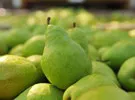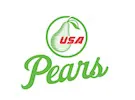 Fall is in full swing, and fresh Pacific Northwest–grown USA Pears are available now in produce sections from coast to coast. As the leaves change colors, Oregon and Washington growers are harvesting an estimated 16 million standard box equivalents of fresh, USA-grown pears. The versatile, high-in-fiber fruit boasts an extended shelf life, helping consumers avoid food waste, and is the perfect complement for any meal — from charcuterie boards and salads to main dishes, baked goods or desserts.
Fall is in full swing, and fresh Pacific Northwest–grown USA Pears are available now in produce sections from coast to coast. As the leaves change colors, Oregon and Washington growers are harvesting an estimated 16 million standard box equivalents of fresh, USA-grown pears. The versatile, high-in-fiber fruit boasts an extended shelf life, helping consumers avoid food waste, and is the perfect complement for any meal — from charcuterie boards and salads to main dishes, baked goods or desserts.
"This year's harvest was slow to start, due to a prolonged cold and wet spring, but the pears coming off the trees were worth the wait," said Jim Morris, marketing manager at Pear Bureau Northwest. "This year's crop is sweet and juicy and boasts a mouth-watering crunch."
Despite the wet spring, USA Pears anticipates a crop on par with its five-year average.
The harvest was bolstered by the Pacific Northwest's extra-long stretch of dry, warm weather. With 10 varieties of fresh pears grown in the Northwest fresh pears can be found in the store almost year-round, from Anjou to Starkrimson.
"Pears are a healthy and nutritious selection for the whole family that can be enjoyed a bit longer, when stored properly," continued Morris. "Simply move your ripe pears to the refrigerator to extend their life 3-5 more days. With food prices on the rise, choosing produce that keeps and that offers a nutritious bang for the buck is all the more important."
Pears rank higher than almost any other fruit when it comes to dietary fiber, with 6 grams or 21% of the recommended daily value in just one pear. Fiber aids in gut health and supports bowel regularity. Fiber-rich diets can also help in the prevention of various conditions and diseases, such as heart disease and some types of cancer.
Further, pears contain other essential nutrients, such as vitamin C and potassium. These compounds are vital for normal metabolism, tissue repair, proper immune function and protection from infectious diseases.
How to Store and Ripen Pears
Pears are among the few fruits that don't ripen on the tree. Rather, they reach maturity when stored at room temperature. This makes pears a perfect choice for decorative fruit bowls or weekend produce shopping that will last throughout the week. To determine when a pear is at its juiciest, USA Pears suggests to "check the neck." If a pear yields when gentle pressure is applied with a thumb to its neck near the stem, then it's ripe and ready to eat. Once ripe, pears can be stored in the refrigerator to slow aging and extend the fruit for a few more days.
To learn more about the health benefits of pears and explore recipes, visit www.USAPears.org.
 For more information:
For more information:
Jim Morris
Pear Bureau Northwest
Tel: +1 (503) 652-9720
Email: jmorris@usapears.com
www.usapears.org/about/
